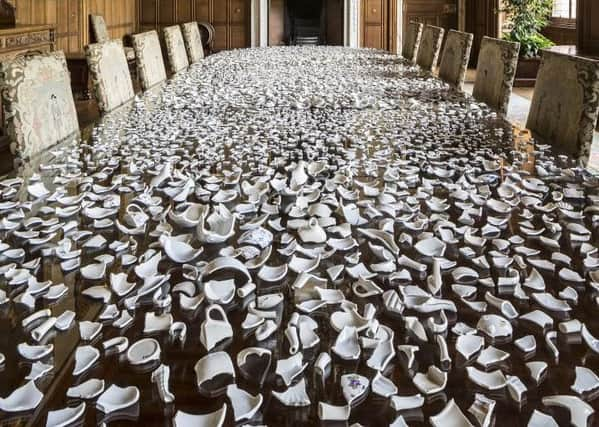Art review: Christine Borland: To the Power of Twelve, Mount Stuart, Isle of Bute


Christine Borland: To the Power of Twelve, Mount Stuart, Isle of Bute ****
Currently working on a major commission for display at Kelvingrove Museum to mark the centenary of the end of the First World War, Borland felt there was more work to be done on this theme at Mount Stuart, which was a naval hospital during that period. To those familiar with her practice, it will be no surprise that the themes of medicine, botany and history appealed to her, but the work that has resulted is anything but predictable.
Advertisement
Hide AdIn the Marble Hall at the centre of the building – once a ward containing beds for 50 men – she has placed an installation of 444 handblown glass balls (this is the title work in the show and multiples of 12 recur throughout). They lie within an encircling Moss Pillow, the hem of an Army surplus parachute stuffed with sphagnum moss, which was harvested in Scotland and used in Army hospitals for its antiseptic properties. The glass is medical grade, the circle 1/12 of the size of a crater on the Messines Ridge, Belgium, which is now a peace memorial.
This layering of meanings and connections, materials and history, is typical of Borland, but sometimes these elements come together, as here, to make something more than the sum of their parts. The glass balls glitter in the dim light, echoing the constellations on the ceiling that map out the signs of the Zodiac (12) and reflect back the colours of the (12) stained glass windows. Transparent yet solid, they feel like fragments of time sealed in glass.
The ornate conservatory off the Horoscope Bedroom (more 12s) was the hospital’s operating theatre. Here, Borland has placed Moss Depository, a parachute filled with sphagnum moss. The strong form and faded red colour speaks of the body, or a great seed pod, strongly sculptural, yet restrained enough to hold a variety of meanings.
In the Dining Room, the table is carefully laid with a mosaic of shattered crockery. China Harvest is the remnant of 144 (12x12) feeding cups, used in hospitals in the early 20th century, and smashed by the bomb disposal unit stationed permanently in Belgium today. Photographs of the cups, which were used to line the container, are displayed on Witness Boards in the Armoury, some damaged, some remarkably unscathed.
In the Gun Room, Borland continues her series from 2003, The Velocity of Drops, in which she photographed split watermelons in the house. Photographs from new locations, mainly in the grounds, seem to open up a wider set of resonances: not only damage, but healing.
The most elusive work here is Floating Groins/Fastened Groins, in the swimming pool. These 12 sculptures, inspired by redundant mathematical models and made from 3D printed shapes laced with nettle thread (a wartime fallback when cotton was scarce), float on the surface of the water. They are delicate and intriguing: viewing them through a glass door, you can’t get as close as you’d like – but their meaning remains opaque, or it did to me, even after several attempted explanations.
Advertisement
Hide AdThis body of work, interwoven with the Arts & Crafts splendour and historical collections of Mount Stuart, is a significant contribution to the art made to reflect on the war centenary. Resolutely contemporary in its approach, it recalls elements of the past, of a near-forgotten history, evoking the men who were cared for here, who returned, alive but not unscathed, from the most terrible of wars.
Until 18 November